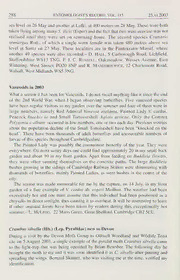
Crambus silvella (Hb.) (Lep. Pyralidae) new to Devon PDF
Preview Crambus silvella (Hb.) (Lep. Pyralidae) new to Devon
288 ENTOMOLOGIST'S RECORD, VOL. 115 25.xi.2003 sea level on 26 May and another at Lafki, at 400 metres on 28 May. These were both taken flying among many S. ilicis (Esper) and the fact that two were acaciae was not realised until they were set on returning home. The second species Cyanaris semiargus Rott., of which a single worn female was taken 480 metres above sea level at Santa on 27 May. These localities are in the Pantokrator Massif, where another 49 species were also recorded - D. Hall, 5 Curborough Road, Lichfield, Staffordshire WS13 TNG, P. J. C. Russell, Oakmeadow, Wessex Avenue, East Wittering, West Sussex PO20 8NP and R. Mandziejewicz, 12 Charlemont Road, Walsall, West Midlands WS5 3NG. Vanessids in 2003 What a season it has been for Vanessids. I do not recall anything like it since the end of the 2nd World War, when began observing butterflies. Five vanessid species I have been regular visitors to my garden over the summer and four of them were in large numbers, namely Red Admiral Vanessa atalanta, Painted Lady V cardui, Peacock Inachis io and Small Tortoiseshell Aglais urticae. Only the Comma Polygonia c-album occurred in low numbers, one or two each day. Previous worries about the population decline of the Small Tortoiseshell have been “knocked on the head”. There have been thousands of adult butterflies and uncountable numbers of larvae of this species throughout Cambridgeshire. The Painted Lady was possibly the commonest butterfly of the year. They were everywhere. On most sunny days one could find approximately 20 in my small back garden and about 10 in my front garden. Apart from feeding on Buddleia flowers, they were often sunning themselves on the concrete paths. The large Buddleia bushes growing in the sidings of Cambridge Railway Station were shimmering with thousands of butterflies, mainly Painted Ladies, as were bushes in the centre of the city. The season was made memorable for me by the capture, on 14 July, in my front garden of a fine example of V. cardui ab. rogeri Meilhan. The weather had been excessively hot and one must assume that this individual had been positioned as a chrysalis in direct sunlight, thus causing it to overheat. It will be interesting to learn if other unusual forms have been taken by readers during this exceptionally hot summer- L. McLeod, 22 Maris Green, Great Shelford, Cambridge CB2 5EE. Crambus silvella (Hb.) (Lep. Pyralidae) new to Devon During a visit by the Devon Moth Group to Offwell Woodland and Wildlife Trust site on 5 August 2003, a single example of the pyralid moth Crambus silvella came to the light-trap that was being operated by Brian Bewsher. The following day he brought the moth to me and it was soon identified it as C. silvella after pinning and spreading the wings. Bernard Skinner, who was visiting me at the time, verified mv identification. NOTES 289 Several subsequent visits both to the Offwell Woodland and Wildlife Trust site and to other likely sites around the immediate area proved negative for this species. This appears to be the first time the species has been seen in Devon - Roy McCormick, 36 Paradise Road, Teignmouth, Devon. Dorytomus salicinus (Gyllenhal) (Col.:Curculionidae) in Dorset On 30 May 1990, tapped a teneral example of a small Dorytomus species from a I mature sallow bush at the base of the land-slipped cliffs at Great Ebb, Eype’s Mouth, Dorset (O. S. grid reference SY 4491). Subsequent examination indicated that the beetle was either D. salicinus (Gyll.) or D. salicis Walton. Distributional data made me suspect that it was probably salicis as salicinus is only securely known from central and northern England and Scotland. As I did not have access to any salicinus for comparison, I sent the specimen to Dr. M. G. Morris who kindly identified the beetle as that species. This record extends the known range of salicinus considerably and makes the unconfirmed record for North Wilts cited in Morris (Morris, M. G., 2002. True Weevils (Part 1). Handbk. Ident. Br. Insects 5, part 17b. Royal Entomological Society/Field Studies Council) appear more credible. 1 thank Dr. Morris for naming the beetle for me- David R. Nash, 3 Church Lane, Brantham, Suffolk COll 1PU. Crambus uliginosellus Zell. (Lep.: Pyralidae), a further larval foodplant and correction of an earlier misidentification In late May and early June 1999, and in late May 2000, at Colaton Raleigh Common, Devon (VC 3) I found larvae of Crambus uliginosellus in silken tubes amongst Sphagnum capillifolium and Campylium stellatum var. stellatum feeding , on an unidentified grass and two species of sedge, one of which I determined as Care)cflacca (Heckford, 1999. Entomologist’s Gaz 50: 223-237; Heckford, 2000. Entomologist’s Gaz. 51: 80-81). In captivity all the larvae ate what I had identified as Carex flacca. Prior to this, the larva was unknown in the British Isles. On 23 May 2003, at the same locality, I found several larvae of this species (moths were reared to confirm identification), in silken tubes at the base of Eriophorum angustifolium growing amongst Sphagnum spp. Each plant had only one larva and the mouth of each tube was slightly below the surface of the Sphagnum, the remainder of the tube descending into it. There were signs of feeding at the base of the Eriophorum and in captivity the larvae ate only parts of the stem and lower parts of the leaves of this plant. As a result of revisiting this locality had an opportunity to reconsider my I identification of the sedge as Carex flacca. As a result of closer examination of the
